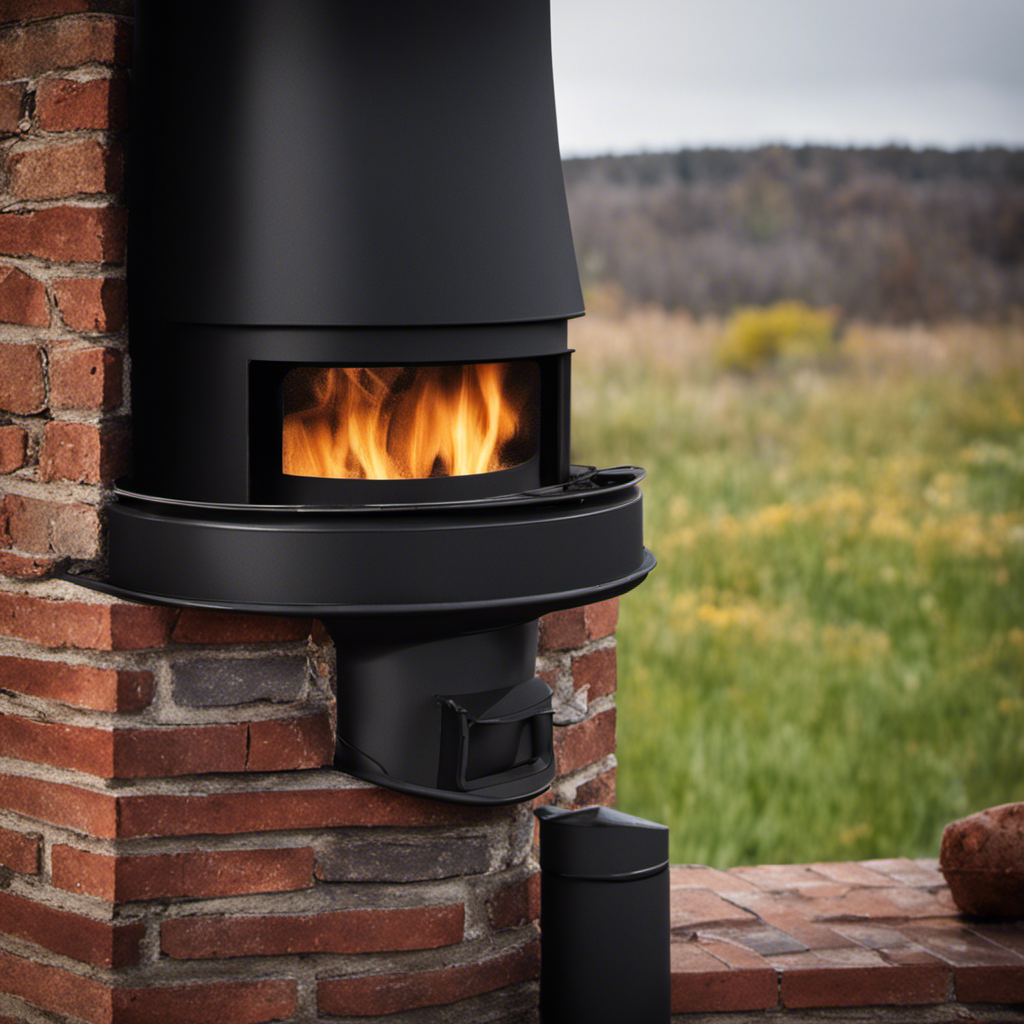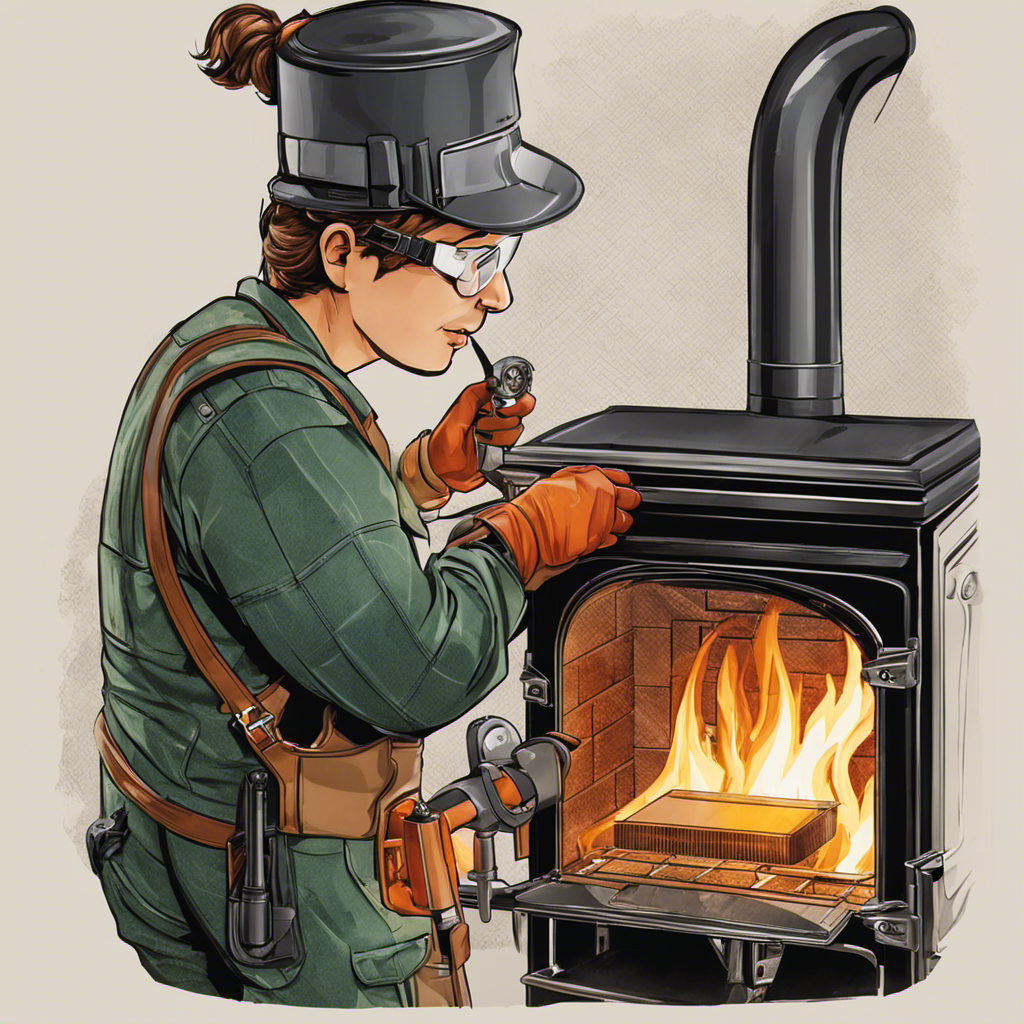Hello there!
Ever noticed that black, grimy buildup around where your wood stove pipe meets the chimney? It’s not the most pleasant sight, but don’t worry, I’ve got you covered.
In this article, I’ll be diving into the common causes of soot accumulation in that area and explaining how chimney draft plays a role. Plus, I’ll share some effective cleaning techniques and preventive measures to keep your wood stove system soot-free.
Let’s get started!
Key Takeaways
- Soot accumulation at the wood stove pipe entry point can lead to chimney blockage and increase the risk of chimney fires.
- Factors such as inadequate chimney draft, blocked flue, and negative air pressure can contribute to soot buildup.
- Effective cleaning techniques, such as using a wire brush attached to a flexible rod, are important for removing soot from wood stove pipes.
- Preventive measures, including using seasoned firewood and scheduling routine cleanings and inspections, can help minimize soot accumulation at the chimney entry.
Common Causes of Soot Accumulation at Wood Stove Pipe Entry Point
I’ve noticed that one common cause of soot accumulation at the wood stove pipe entry point is a blockage in the chimney. When the chimney is blocked, the smoke and gases produced by the wood stove can’t escape properly, leading to a buildup of soot. This can be dangerous as it increases the risk of chimney fires.
Chimney fires occur when the accumulated soot ignites due to high temperatures. To prevent chimney fires and address this issue, it’s essential to be aware of signs of chimney blockage. These signs include a strong, smoky smell in the house, difficulty in starting a fire, and visible soot or creosote buildup on the chimney walls.
Regular chimney inspections and proper maintenance can help identify and address blockages before they become a serious fire hazard.
Understanding the Role of Chimney Draft in Soot Buildup
One must understand the role of chimney draft in soot buildup to effectively prevent chimney fires. Chimney draft problems can lead to the accumulation of soot in the chimney and wood stove pipe, impacting the overall performance of the chimney.
Here are three key points to consider:
-
Inadequate chimney draft can cause a backflow of smoke and gases into the living space, resulting in increased soot buildup. This can occur due to factors such as a blocked or restricted flue, improper chimney height, or negative air pressure within the house.
-
Soot accumulation reduces the efficiency of the chimney by obstructing the flow of exhaust gases. This can lead to poor combustion, decreased heat output, and increased fuel consumption.
-
Excessive soot buildup increases the risk of chimney fires. Soot is highly flammable and can ignite if exposed to high temperatures or sparks from the fire.
Understanding the impact of soot accumulation on chimney performance is crucial for maintaining a safe and efficient wood stove system. Now let’s explore effective cleaning techniques for soot-covered wood stove pipes.
Effective Cleaning Techniques for Soot-Covered Wood Stove Pipes
My preferred method for cleaning soot-covered wood stove pipes is using a wire brush attached to a flexible rod. This technique allows for thorough cleaning of the pipes, removing any accumulated soot and ensuring efficient operation of the wood stove.
Before starting the cleaning process, it’s important to gather the necessary tools and materials. This includes the wire brush, a flexible rod, cleaning products specifically designed for soot removal, and protective gear such as gloves and goggles. DIY methods using household items like vinegar or baking soda may seem appealing, but it’s crucial to use cleaning products specifically formulated for soot removal to ensure effective results.
It’s also important to follow safety guidelines and instructions provided by the manufacturer when using cleaning products. Regular cleaning of the wood stove pipes is essential for optimal performance and reducing the risk of fire hazards.
Preventive Measures to Minimize Soot Accumulation at Chimney Entry
To prevent excessive soot accumulation at the entry of the chimney, it’s important to regularly clean and inspect the wood stove pipes, ensuring proper ventilation and reducing the risk of blockages.
Here are some key strategies and maintenance tips to help minimize soot buildup:
-
Use seasoned firewood: Burning dry, seasoned firewood significantly reduces the amount of soot produced. Moisture content in the wood contributes to increased soot formation.
-
Properly size the wood stove pipes: Ensure that the diameter of the stove pipes matches the requirements of your wood stove. Properly sized pipes optimize airflow and reduce the likelihood of soot accumulation.
-
Regular cleaning and inspection: Schedule routine cleanings for your wood stove pipes to remove any soot and creosote buildup. Inspect the pipes for signs of damage or blockages that may impede proper ventilation.
Professional Solutions for Persistent Soot Issues in Wood Stove Systems
I have found that hiring a professional chimney sweep on an annual basis significantly reduces the persistent soot issues in my wood stove system. Regular chimney inspection and soot removal services play a crucial role in maintaining the efficiency and safety of the wood stove.
A professional chimney sweep will thoroughly inspect the chimney, checking for any signs of damage, blockages, or creosote buildup. They’ll then use specialized tools to remove the soot, ensuring that the flue is clear and allowing for proper ventilation. This not only prevents the accumulation of soot in the wood stove system but also minimizes the risk of chimney fires.
Additionally, a professional chimney sweep can provide valuable insights and advice on proper wood-burning techniques and maintenance practices. Investing in professional chimney services is an essential step in keeping your wood stove system running smoothly and safely.
Frequently Asked Questions
How Often Should I Clean My Wood Stove Pipe to Prevent Soot Buildup at the Chimney Entry?
I clean my wood stove pipe regularly to prevent soot buildup at the chimney entry. DIY remedies like brushing and vacuuming can also help. It’s important to maintain a clean pipe for proper ventilation and to avoid fire hazards.
Can a Damaged or Improperly Installed Chimney Cap Contribute to Visible Soot Accumulation at the Wood Stove Pipe Entry Point?
Yes, a damaged or improperly installed chimney cap can contribute to visible soot accumulation at the wood stove pipe entry point. It can allow debris and soot to enter the pipe, leading to buildup. Regular inspection and maintenance are crucial to prevent this issue.
Are There Any Specific Types of Wood or Fuel That Are More Likely to Cause Soot Buildup at the Chimney Entry?
Certain types of wood and fuel can contribute to soot buildup at the chimney entry. Pine, for example, tends to produce more creosote, a byproduct that can lead to visible soot accumulation.
What Are Some Signs That My Wood Stove System May Have a Draft Problem Contributing to Soot Buildup at the Chimney Entry?
Some signs of draft problems in my wood stove system that can cause soot buildup at the chimney entry include: weak or inconsistent flames, difficulty starting a fire, and smoke escaping into the room.
Are There Any DIY Remedies or Products That Can Help Reduce Soot Accumulation at the Wood Stove Pipe Entry Point?
I’ve found some great DIY remedies and soot prevention products that can help reduce accumulation at the wood stove pipe entry point. Let me share some technical details and information with you.
Conclusion
In conclusion, neglecting the visible soot accumulation at the wood stove pipe entry point can cause your chimney to resemble a blackened beast, ready to unleash its smoky fury upon your home. The chimney draft plays a crucial role in the buildup of soot. However, there are effective cleaning techniques and preventive measures that can help you tame this sooty monster.
Fear not! With proper maintenance and regular cleaning, you can prevent excessive soot buildup in your chimney. Regularly inspect the wood stove pipe entry point for any signs of soot accumulation and clean it as needed. Additionally, using seasoned firewood and ensuring proper airflow in your wood stove system can also help reduce soot buildup.
If despite your best efforts, the soot problem persists, it may be time to seek professional solutions. Professional chimney sweeps have the expertise and tools to thoroughly clean your chimney and address any underlying issues that may be contributing to the excessive soot buildup.
Remember, a clean and well-maintained chimney not only ensures the efficient functioning of your wood stove system but also helps prevent potential fire hazards. So, take the necessary steps to conquer the persistent soot issues in your wood stove system and enjoy a cozy and safe home environment.
Growing up surrounded by the vast beauty of nature, Sierra was always drawn to the call of the wild. While others sought the comfort of the familiar, she ventured out, embracing the unpredictable and finding stories in the heartbeat of nature.
At the epicenter of every remarkable venture lies a dynamic team—a fusion of diverse talents, visions, and passions. The essence of Best Small Wood Stoves is crafted and refined by such a trio: Sierra, Logan, and Terra. Their collective expertise has transformed the platform into a leading authority on small wood stoves, radiating warmth and knowledge in equal measure.











